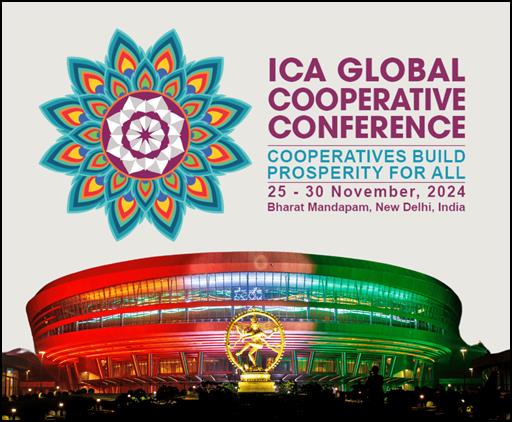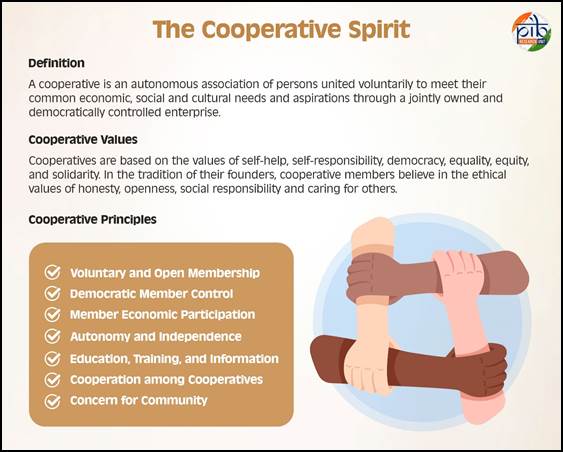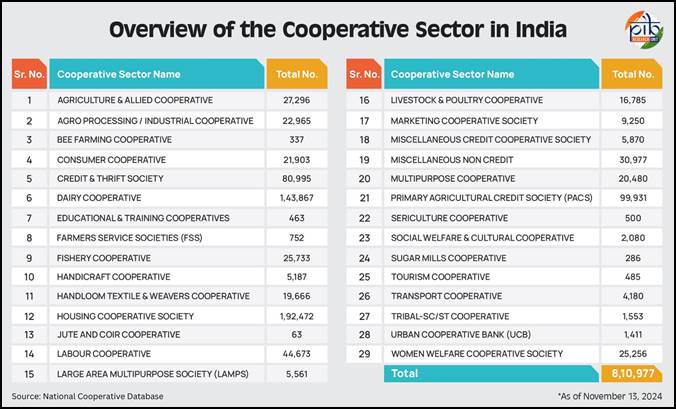India’s Cooperative Movement: Driving Inclusive Growth
India’s Cooperative Movement: Driving Inclusive Growth
Introduction
The cooperative movement in India has deep roots, drawing inspiration from the ancient Indian ethos of Vasudhaiva Kutumbakam, which translates to “the world is one family.” This enduring principle of unity and mutual support has fostered the growth of cooperatives as vital institutions that empower local communities and drive grassroots development. According to the International Cooperative Alliance (ICA), cooperatives are member-owned enterprises that prioritize shared economic, social, and cultural objectives, placing people above profit. In India, cooperatives have transformed countless lives by enabling marginalized communities to access resources, secure livelihoods, and participate in the economy.

The establishment of the Ministry of Cooperation on July 6, 2021, underscored India’s commitment to enhancing the cooperative sector. The Ministry envisions an inclusive, cooperative-driven economic model that reaches every village, strengthening socio-economic bonds across regions. As India prepares to host the ICA’s Global Conference in November 2024, an event facilitated by the Indian Farmers Fertilizer Cooperative (IFFCO) and supported by India’s 18 ICA member organizations, the country stands poised to further elevate the cooperative movement both nationally and globally.
Understanding Cooperative Societies
A cooperative society is a voluntary organization where individuals with shared needs come together to achieve common economic goals. These societies are founded on principles of self-help and mutual assistance, aiming primarily to serve the interests of disadvantaged sections of society rather than to generate profits. Members pool their resources and utilize them collectively to derive shared benefits, making the cooperative structure distinct in its emphasis on community welfare.

Some different types of Cooperative Societies in India:
v Producers’ Cooperative Society: Supports small producers by providing necessary production items such as raw materials and equipment. Notable examples are APPCO and Haryana Handloom.
Evolution of Cooperative Movement in India
Even before the formal establishment of cooperative structures through legislation, the principles of cooperation were already ingrained in various parts of India. Village communities often engaged in collective activities, creating permanent assets such as village tanks or forests known as Devarai or Vanarai. These community efforts were vital to local survival and prosperity. In different regions, various forms of cooperation emerged, such as Chit Funds, Kuries, Bhishies, and Phads. In the Madras Presidency, Mutual-Loan Associations, also called ‘Nidhis’, were organized to provide financial support. In Punjab, a cooperative society was established in 1891 to manage common village land for the benefit of all co-sharers. These efforts, however, were voluntary and informal, operating outside the official framework.
The modern cooperative movement in India began to take shape in response to the distress and turmoil of the late 19th century. The aftermath of the Industrial Revolution led to widespread displacement of rural populations, with many turning to agriculture as the sole means of livelihood. However, agricultural practices were hampered by issues such as land fragmentation, which rendered farming uneconomic, and the rigid collection of land revenues. Farmers faced recurring challenges such as erratic rainfall, poor crop yields, and a growing dependence on moneylenders, who often offered high-interest loans or bought crops at exploitative prices. These harsh conditions underscored the urgent need for affordable credit, paving the way for the formalization of the cooperative movement as an alternative means of financial support for farmers and rural communities.
The history of Cooperative Movement in India can be divided into two phases. First, cooperative Movement in the Pre-Independence era and second in the Post-Independence era.
Cooperative movement in the Pre Independence-Era
Cooperative movement in the Post Independence-Era
Resurgence of the Cooperative Movement in India
The Ministry of Cooperation (MoC), established on 6th July 2021, has played a pivotal role in revitalizing the cooperative movement in India. It has spearheaded various schemes and initiatives to create a robust administrative, legal, and policy framework for the sector’s advancement. A key focus of the MoC is the promotion of Multi-State Cooperative Societies and streamlining procedures to enhance the “Ease of Doing Business” for cooperatives. The Ministry’s efforts are centred on modernizing and strengthening cooperatives, fostering transparency through computerization, and promoting competitiveness. Additionally, there is a strong emphasis on ensuring inclusive development, particularly for underserved rural communities. Through its initiatives, the MoC aims to connect every village to cooperatives, driving economic prosperity under the banner of ‘Sahakar se Samriddhi,’ contributing to the nation’s overall growth.
Key Government Initiatives for Upgrading the Cooperative Sector (As of February 6, 2024):
Cooperative Sector at a Glance
Cooperative societies in India operate across various sectors such as Agriculture, Credit and Banking, Housing, and Women’s Welfare. They are instrumental in promoting financial inclusion by providing credit to farmers and small entrepreneurs who may have difficulty accessing conventional banking services. These societies play a crucial role in rural development, empowering local communities and reducing socio-economic disparities.

Conclusion
India’s cooperative movement, deeply rooted in its cultural and socio-economic landscape, has evolved into a powerful vehicle for inclusive growth, community empowerment, and rural development. Through the establishment of the Ministry of Cooperation and its recent initiatives, the government has reaffirmed its commitment to fostering a cooperative-driven model that reaches every corner of the country, facilitating sustainable livelihoods and financial inclusion for marginalized communities. The upcoming Global Conference of the International Cooperative Alliance (ICA), hosted by India in November 2024, marks a significant milestone in this journey, offering a platform to showcase India’s innovative strides in the cooperative sector to a global audience. This event not only highlights India’s dedication to strengthening cooperatives nationally but also its leadership role in advancing the cooperative model worldwide, reinforcing the vision of ‘Sahakar se Samriddhi’ as a guiding principle for prosperity and unity.
References:
- Consumers’ Cooperative Society: Formed to provide consumer goods at reasonable prices, eliminating middlemen by purchasing directly from producers. Examples include Kendriya Bhandar and Apna Bazar.